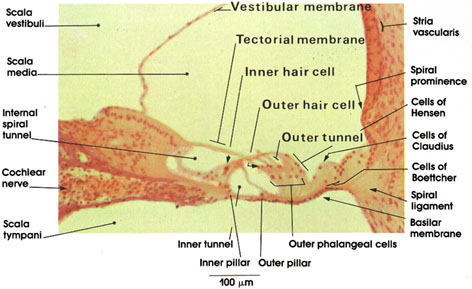

Plate 16.312 Organ of Corti
Ronald A. Bergman, Ph.D., Adel K. Afifi, M.D., Paul M. Heidger,
Jr., Ph.D.
Peer Review Status: Externally Peer Reviewed

Guinea pig, 20% formalin, H. & E., 162 x.
This plate is a cross section of the bony cochlea and shows three compartments: the upper, scala vestibuli; the lower, scala tympani; and the middle, scala media. The scala vestibuli and scala tympani are perilymphatic spaces. The scala vestibuli reaches the inner surface of the oval window. The scala tympani reaches the inner surface of the round window. Both scalae communicate at the helicotrema at the apex of the cochlea. The scala media or cochlear duct is part of the endolymphatic system and contains the organ of Corti. The vestibular membrane or Reissner's membrane forms the roof of the cochlear duct. The basilar membrane forms the base of the cochlear duct and gives support to the organ of Corti.* The outer wall of the cochlear duct is made up of the spiral ligament, which is a thickening of the periosteum. The crest of the spiral ligament forms the spiral prominence. The part of the spiral ligament between the spiral prominence and the vestibular membrane is the stria vascularis. The epithelium here is thick and pseudostratified. The subepithelial connective tissue is rich in capillaries. The stria vascularis is believed to be active in the production of endolymph and the regulation of its ion content. The epithelium of the spiral prominence continues onto the basilar membrane. Cells here become cuboidal. Those cells continuing onto the pars pectinata of the basilar membrane are known as cells of Claudius.* In parts of the cochlea, polyhedral cells separate the Claudius cells and the basilar membrane and are known as cells of Boettcher.* The organ of Corti is composed of two types of cells, supporting and hair cells. The supporting cells are tall, slender cells extending from the basilar membrane to the free surface of the organ of Corti. The supporting cells include the outer and inner pillars, inner and outer phalangeal cells, and cells of Hensen.* The inner tunnel within the organ of Corti is bounded below by the basilar membrane and above by the outer and inner pillar cells. The outer phalangeal cells act as supporting elements for the three to four rows of outer hair cells. The cells of Hensen are located adjacent to the last row of outer phalangeal cells. They constitute the outer border of the organ of Corti. The hair cells are of two types: the inner and outer hair cells. The inner hair cells are in a single row. The outer hair cells form three rows lodged between the outer pillar and outer phalangeal cells. The tectorial membrane is in contact with the hairs of hair cells and transmits to them endolymph vibrations. The cochlear nerve is formed by central processes of the bipolar cells of the spiral ganglion. In the inner angle of the scala media, the periosteal connective tissue of the spiral lamina bulges into the scala media overhanging the internal spiral tunnel.
*Corti was a nineteenth-century Italian anatomist, Claudius and Hensen were nineteenth-century German anatomists, and Boettcher was a nineteenth-century Estonian anatomist.
Next Page | Previous Page | Section Top | Title Page
Please send us comments by filling out our Comment Form.
All contents copyright © 1995-2025 the Author(s) and Michael P. D'Alessandro, M.D. All rights reserved.
"Anatomy Atlases", the Anatomy Atlases logo, and "A digital library of anatomy information" are all Trademarks of Michael P. D'Alessandro, M.D.
Anatomy Atlases is funded in whole by Michael P. D'Alessandro, M.D. Advertising is not accepted.
Your personal information remains confidential and is not sold, leased, or given to any third party be they reliable or not.
The information contained in Anatomy Atlases is not a substitute for the medical care and advice of your physician. There may be variations in treatment that your physician may recommend based on individual facts and circumstances.
URL: http://www.anatomyatlases.org/